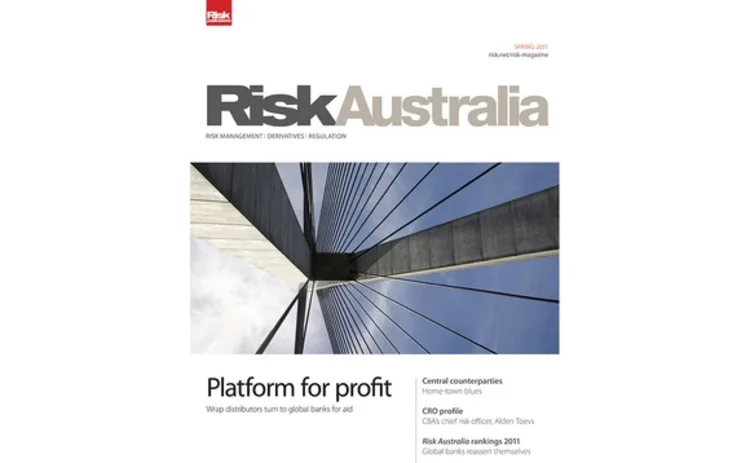
Risk Australia Spring 2011

Market participants in the Australian financial sector have received some interesting deliveries during the past six months. These tricky shifts have come as many participants have only recently adjusted to the new, post-global financial crisis order.
The new ‘norms’ appeared to include increased government debt issuance, an Australian dollar trading above parity against the greenback, reduced use of exotic instruments, a strong domestic property market and a tight onshore loan market.
Reform by the Basel Committee on Banking Supervision aimed at improving both the capital and liquidity positions of financial institutions – which will be largely adopted in Australia – would mean large Australian institutions, such as ANZ, Commonwealth Bank of Australia and National Australia Bank, would need to consistently seek long-dated, assets offshore to bolster their capital bases. In turn, this would continue to drive spreads of the floating-to-floating, cross-currency basis swap market wider as financial institutions would need to swap their long-term debt raised in the US dollar and euro markets back into Australian dollars.
Despite relatively robust economic growth – the International Monetary Fund still expects Australian gross domestic product to rise by 3% this year – fundraising by Australian banks offshore has fallen well below expectations. This is partly due to banks aggressively moving to attract domestic deposits as an alternative to raising money in the capital markets. It is also partly due to loan growth onshore being lower than expected, in part due to some Australian corporates having raised substantial funds offshore themselves during the past year, sometimes at lower spreads than Australian financials.
Meanwhile, derivatives use is picking up in some market segments due to a lack of real direction or momentum in a number of asset classes, including equities – perhaps with the exception of the mining sector. Concern about range-bound markets has resulted in some investors using derivatives to conduct relative-value and other trades in a bid for excess returns.
Indeed, derivatives based on the strength of the Australian economy have been used as the basis of bets made by a number of international hedge funds. This involves fund managers protecting themselves in the event of an Australian default by buying credit default swaps (CDSs) referencing Australia’s sovereign debt. The idea is to obtain cheap insurance against the possibility of a downturn in China, which would likely cause Australian sovereign CDS spreads to widen substantially given China’s high demand for Australian commodities and other goods.
Australia’s financial markets have been tougher to read during the past few months and it looks likely that the next few months could prove just as challenging.
Only users who have a paid subscription or are part of a corporate subscription are able to print or copy content.
To access these options, along with all other subscription benefits, please contact info@risk.net or view our subscription options here: http://subscriptions.risk.net/subscribe
You are currently unable to print this content. Please contact info@risk.net to find out more.
You are currently unable to copy this content. Please contact info@risk.net to find out more.
Copyright Infopro Digital Limited. All rights reserved.
As outlined in our terms and conditions, https://www.infopro-digital.com/terms-and-conditions/subscriptions/ (point 2.4), printing is limited to a single copy.
If you would like to purchase additional rights please email info@risk.net
Copyright Infopro Digital Limited. All rights reserved.
You may share this content using our article tools. As outlined in our terms and conditions, https://www.infopro-digital.com/terms-and-conditions/subscriptions/ (clause 2.4), an Authorised User may only make one copy of the materials for their own personal use. You must also comply with the restrictions in clause 2.5.
If you would like to purchase additional rights please email info@risk.net
More on Risk management
Review of 2025: It’s the end of the world, and it feels fine
Markets proved resilient as Trump redefined US policies – but questions are piling up about 2026 and beyond
BofA urges horizontal CCP fix after CME outage, others demur
Analysts say clearing meltdown bolsters case for futures-for-futures exchange with FMX
One in five banks targets a 30-day liquidity survival horizon
ALM Benchmarking research finds wide divergence in liquidity risk appetites, even among large lenders
Bank ALM tech still dominated by manual workflows
Batch processing and Excel files still pervade, with only one in four lenders planning tech upgrades
Many banks ignore spectre of SVB in liquidity stress tests
In ALM Benchmarking exercise, majority of banks have no internal tests focusing on stress horizons of less than 30 days
Quant Finance Master’s Guide 2026
Risk.net’s guide to the world’s leading quant master’s programmes, with the top 25 schools ranked
ALM Benchmarking: explore the data
View interactive charts from Risk.net’s 46-bank study, covering ALM governance, balance-sheet strategy, stress-testing, technology and regulation
Staff, survival days, models – where banks split on ALM
Liquidity and rate risks are as old as banking; but the 46 banks in our benchmarking study have different ways to manage them







